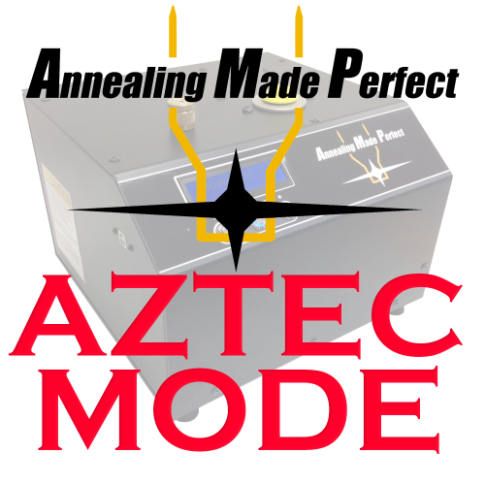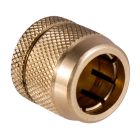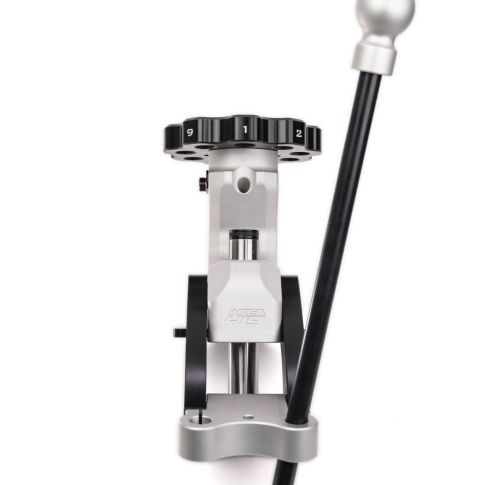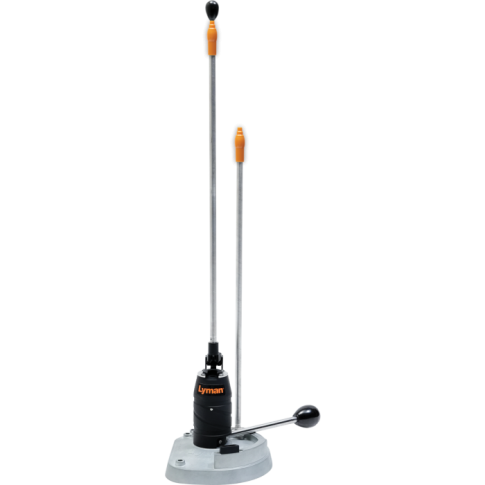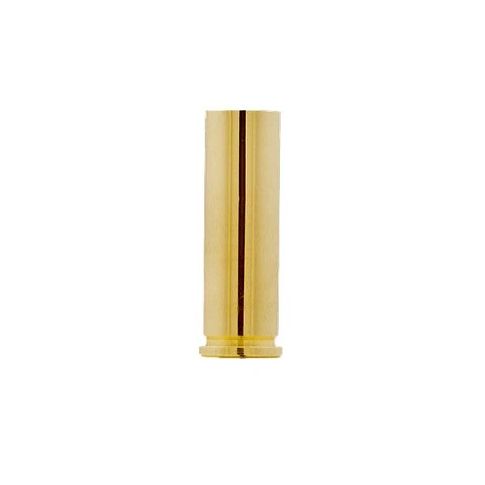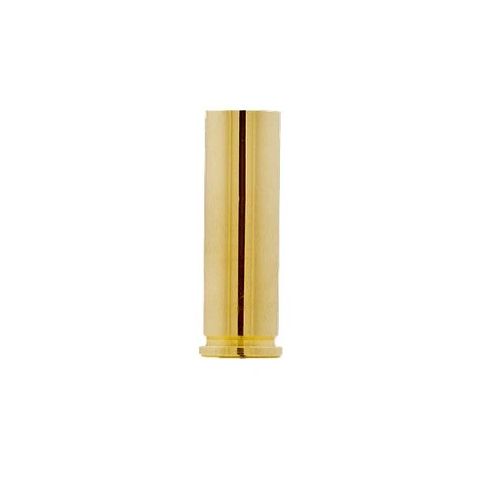Be the first to review this product
**PLEASE NOTE, YOUR UNLOCK CODE WILL BE EMAILED DIRECTLY TO YOU WITHIN 48 HOURS FROM PURCHASE. YOU CAN DOWNLOAD THE SOFTWARE DIRECTLY FROM AMPS WEBSITE AT ANY TIME.
AMP recently premiered their brand-new software called Aztec Mode at Shot Show. It allows users to calibrate their own cases without sending samples to New Zealand. It is not a firmware update or patch. It is a major upgrade in the way the annealer operates. A provisional patent has been lodged. It will be downloadable from AMP’s web site using the USB cable supplied with the annealer, website: . When downloaded, it will be locked. The code to unlock can be purchased from us right here. Aztec will also be an optional extra on new annealers.
AMP recently premiered their brand-new software called Aztec Mode at Shot Show. It allows users to calibrate their own cases without sending samples to New Zealand. It is not a firmware update or patch. It is a major upgrade in the way the annealer operates. A provisional patent has been lodged. It will be downloadable from AMP's web site using the USB cable supplied with the annealer, website: . When downloaded, it will be locked. The code to unlock can be purchased from us right here. Aztec will also be an optional extra on new annealers. It will not be included in the base price. Here is a short video.
Aztec runs in a different manner to our standard programs, and they don’t correlate. It doesn’t do the series of pulses which you would be used to. It is quicker and quieter than our standard programs. The end result is the same neck and shoulder annealed hardness. Because it is quicker, about one millimetre less of the body down from the shoulder is annealed. That is just a "run out” area anyway, and is not significant.
It also has a "Sort mode” mass comparator which allows the user to batch sort their cases based on the mass of the annealed portion of the case – neck, shoulder and front section of the body. The precision shooters we talked to at Shot Show thought this was a particularly valuable feature. Here is another short video showing the Sort mode in action:
Your annealer will continue to function just fine without Aztec. Should you choose to upgrade, it will be because you think it is worth it. Shortly we will in fact be releasing a free software update which will extend the standard programs to P160 to give the ability to correctly anneal the WSSM family of cases with their very thick wall sections. It will also have the latest standard software version.
The guys at AMP discussing the basics of using AZTEC and how to get the best out of it:
Basic operation and selecting a function
AZTEC is self-prompting and very simple to use with minimal technical expertise.Once AZTEC has been installed into your annealer, the start-up display will show:
MODE SELECT
AZTEC STANDARD
For all selections the cursor is controlled by the and – buttons. The start button is the selector. If you wish to use AZTEC mode, press Start. If you wish to use the standard programs, press . Now the word STANDARD will pulse. Pressing Start will lock in the STANDARD programs for use.
If you have selected AZTEC, firstly "Patent Pending” will show, and then the following options:SORT, ANALYSE, and RUN. Use the button to scroll to your choice, then press Start to select.
If you have selected SORT, insert the correct pilot for your cartridge, then insert a case. Press Start to zero the first case. All subsequent cases will be detected and evaluated automatically upon insertion. They will be compared to the first "zero” case. DO NOT PRESS START AFTER THE FIRST CASE, otherwise you will re-zero to the current case. For more detail on this function see "Using SORT mode”.
To exit SORT mode, press and hold the – button and then Start, holding both buttons down briefly. This will take you back to the main menu.
Then press to move to ANALYSE. Select with the Start button.
The display will show "ENTER PILOT NUMBER”, with three zeros and the letter A. Insert the correct pilot into the annealer. Note: The actual pilots remain the same as for our standard programs. Those same pilots have been assigned a three-digit AZTEC code with a single letter suffix. This code instructs the annealer as to which cartridge it is analysing. Some of our pilots have a B prefix engraved on the top such as B29 for 300 Win Mag. Please ignore that B. It just stands for "belted” and has no relevance to the AZTEC codes.
The cursor will be under the first zero. Press Start to confirm the first zero and the cursor will move to the second zero. Press the button one step at a time until the correct second digit for your pilot code appears, then press Start to select. The cursor will move across to the third digit. Repeat the procedure until the correct third pilot digit appears, then press Start to select. The cursor will move to the letter A. Either select A with Start, or press to select the correct suffix for your pilot code. If at any time you make an incorrect entry, just hold down – and then press Start at the same time. This will take you back to the main menu. Start again.
Once the correct pilot code is entered, the display will show "ANALYSE” This means it is ready to go. Insert your sacrificial case into the annealer and press Start. The annealer will start heating the case. You will hear the annealer running and then stop. Do not remove the case until the red Start light goes out. Take care when removing the case from the annealer – it will be VERY hot. Make sure you have a suitable heat proof tray to deposit it in. It is also useful to have a pair of pliers handy. The case will have heated right up to melting point. Depending on the case shape, occasionally they can stick a little in the pilot. Note: ANALYSE mode will not harm your annealer. Make sure to remove the case after the red light goes out and eject it from the shell holder. Otherwise heat will transfer to the brass shell holder grip, which may become uncomfortably hot.
Once the red Start light goes out the display will show a four-digit Code number, and "USE” will be pulsing. Make sure to record that number for future use when you are annealing the same cases again. It will not be stored to memory in the annealer. If you wish to carry straight on with annealing a batch of cases, select "USE”. Now "RUN” will be displayed with the code. Beside the code will be a 0 and a * program lock. See "Advanced functions” for an explanation.
Insert the first case and press Start to activate "RUN”, and your first case will be annealed. This display will remain for the annealing session. Anneal each case by pressing Start, as with our standard programs.
Note: in all instances AZTEC will anneal quicker than our Standard programs for the same case. This is because it operates in a different mode. It will also sound different. You won’t hear the familiar "tick-tick-tick” that you are used to.
If you are starting a new annealing session and already know the code for your cases, there is no need to sacrifice another case. Just select RUN from the starting menu. Then insert the correct pilot, enter your code and start annealing.
Selecting the correct sacrificial case
It is important that the sacrificial case is representative of the cases you are going to anneal. The two most significant factors are neck wall thickness and case weight. If cases have been accurately neck turned that makes the task simple. If not, use a ball micrometer to check neck wall thicknesses. We suggest checking say ten cases and selecting an average representative.
There is some debate about the merits of sorting cases by weight for competition shooting. We can’t comment on the benefits or otherwise on downrange accuracy, but we have found that case weight affects the correct annealing setting more often than not. We always sort customer samples for case weight as part of our laboratory procedure when calibrating standard program settings. You don’t need the most sophisticated scales for this task. We use a simple digital scale accurate to 0.1 g. We are not looking for tiny variations. We treat anything over 0.5 gr. as potentially significant. Two grains or more will frequently affect the annealing outcome. For hunting cases the difference is inconsequential. For competition, every bit matters.
Provided the brass is generally of good quality, there will be minimal variation in annealing across a whole batch if the best median case is selected as the sacrifice. With match quality turned and sorted brass there should be virtually no annealed variation.
We recommend that the sacrificial case should be fire formed and unsized. That is when cases should be annealed in the reloading cycle. There can be minor but significant differences in the code which AZTEC will allocate between sized and unsized cases.
We have found no difference in the code allocation using clean or dirty cases. We have also found that trim to length dimensions (within reason) have no effect on the code allocation.
Note: AZTEC generates many hundreds of codes with very fine increments. They are not sequential/linear. If two similar cases of the same cartridge and brand are sacrificed, it is not uncommon for two seemingly very different codes to be generated. In reality the annealing result will be almost identical. Once a code has been generated for a case, stick with it. You will get the same annealing every reload.
Using SORT mode
SORT mode is a work in progress. When it was debuted at Shot Show 2018 we believed that it was purely a mass comparator of the neck and shoulder region of the cases. We now know that it also compares dimensions. It is very sensitive to case length, fire formed v sized, and even mouth chamfering. If a case is even slightly out of round, it will give different readings if rotated a quarter turn on successive readings. Note: leave two seconds between extracting one case and inserting the next.
These dimensional influences can show larger variations in SORT mode than the actual mass variations, and it is necessary to eliminate them before looking at mass. In that respect we believe it is a valuable tool in checking case uniformity. Will it identify a "flier” case? That we do not yet know. We will be working with a ballistics laboratory on that question.
Advanced Functions
As mentioned in "Basic operation and selecting a function”, after a sacrificial case is analysed and USE is entered, the display will show RUN with a 0 and a * program lock to the right. The codes generated by AZTEC are not sequential, so any adjustment the reloader might want to make could otherwise difficult. The 0 gives the user that ability to customise their annealing.
To access the 0, firstly the * program lock must be opened. Just hold down the button for two seconds and the * will disappear. Now the /- buttons can be used to select up to six incremental adjustments up or down. These adjustments have been calibrated to give the same annealed hardness (HV) increments regardless of the cartridge. This means that the HV value per step is the same for say a 22 Hornet or a 338 Lapua Magnum. Each step represents approx. 2.5 HV, so that four steps will give approx. 10 HV up or down.
We always recommend that the ANALYSE generated code is used, because in our opinion it gives the optimal neck and shoulder annealed hardness. We do understand however that many reloaders will appreciate the ability to experiment.
| Type of product | Annealing Equipment |
|---|---|
| SKU's | amp-71041 |
| Brand | AMP Annealing |
FAQ - Frequently Asked Questions
Welcome to our purchasing FAQ! Here you'll find answers to our most asked questions regarding purchasing from us. If you are after Reloading FAQ's, please click HERE, where you can find more specific question and answers. Still can't find quite what you're looking for, or have something we should know? Send us an email, we're happy to help!
-
Q1: Do you ship to my country?
A1: European countries (All items except Ammunition, Powders, Primer, Cases & Projectiles)
-
Q2: How much do I pay for shipping?
A2: The shipping charge will be added to your order and visible on your receipt before you check out. The shipping is based on the destination country. You’ll get free shipping on orders above a certain amount.
Free shipping on orders above: £50 for mainland UK next day deliveries.
France - £25
Norway – £45
Finland – £46
Germany – £25
UK – £5 (Free UK Mainland with purchases over £50)
Rest of the EU – £25-100
Global – £100-200 -
Q3: What are the accepted payment methods?
A3: We accept online card payment with MasterCard, VISA, Worldpay or Bank Direct Debit
-
Q4: What currency do I pay in?
A4: The currencies used are GBP, EUR & USD The currency is chosen automatically depending on your shipping country.
-
Q5: When do I receive my order?
A5: We dispatch all orders in 1-2 business days with DPD & Parcelforce, delivery time will depend on the shipping country and address.
-
Q6: Do I have to pay international taxes and duties?
A6: Your order may be subject to import duties and taxes, which are levied once a shipment reaches your country. We cannot control and is not responsible for any duties/taxes applied to your package upon delivery. You will be responsible for paying additional charges for customs clearance. Customs policies vary widely from country to country; please contact your local customs office for further information.
- Set up your reloading bench where it (and stored components) will not be exposed to heat, sparks or flame.
- Establish a comfortable loading procedure and don't vary it.
- Keep your reloading bench, equipment and area clean and uncluttered. Label components and reloads for safe, easy identification. Never use powder from an unlabelled tin.
- Understand what you are doing and why it must be done in a specific way.
- Follow loading recommendations exactly. Don't substitute components for those listed in metallic data without reducing the load and working back up.
- Never substitute smokeless powder for black powder or Pyrodex because smokeless powder is much more powerful than black powder. Never mix two powders together.
- Wear safety glasses.
- Stay alert when reloading. Don't reload when distracted, disoriented or tired.
- Don't smoke, drink alcohol or take drugs while reloading or while in your reloading area.
- Keep everything out of reach of small children.
| Rifle Calibre Name | Common Metric Name | Bullet Diameter |
| .17 | 4.5mm | .172" |
| .204 | 5.2mm | .204" |
| .223 | 5.56mm | .224" |
| .22 (Rimfire) | 5.6mm | .223" |
| .22 (Centrefire) | 5.6mm | .224" |
| .243 | 6mm | .243" |
| .257 | 6.53mm | .257" |
| .260 | 6.5mm | .264" |
| .270 | 6.8mm | .277" |
| .280 | 7mm | .284" |
| .30 | 7.62mm | .308" |
| .325 | 8mm | .323" |
| .33 | 8.6mm | .338" |
| .366 | 9.3mm | .366 |
| .375 | 9.5mm | .375" |
| .416 | 10.6mm | .416" |
| .50 | 13mm | .510" |
Ratings & Reviews
Be the first to review this product


